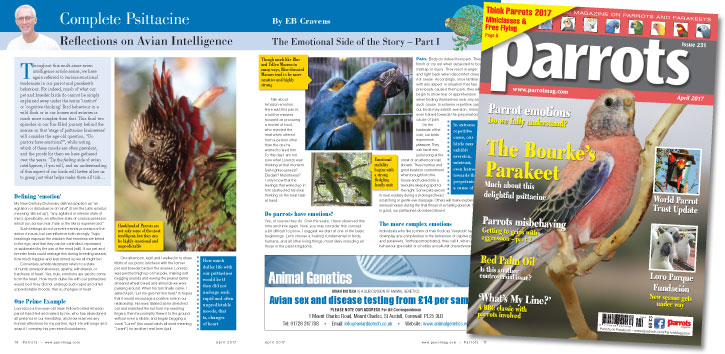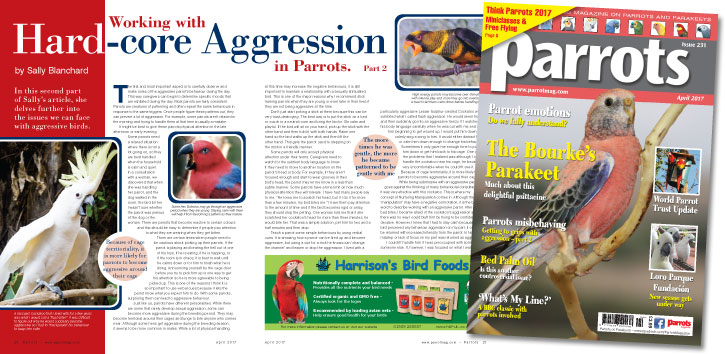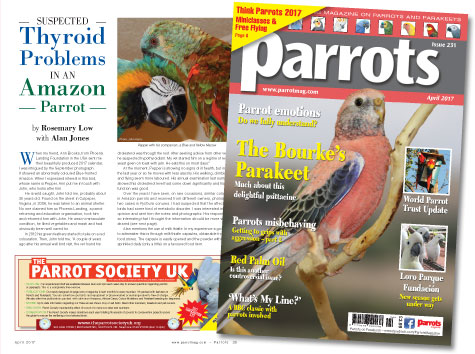
Complete Psittacine by Eb Cravens
Throughout this multi-issue avian intelligence article series, we have again referred to various emotional tendencies in our parrot and parakeet’s behaviour. For indeed, much of what our pet and breeder birds do cannot be simply explained away under the terms ‘instinct’ or ‘cognitive thinking’ Bird behaviour in a wild flock or in our homes and aviaries is much more complex than that. This final two episodes in our fun-filled journey behind the scenes on that ‘stage of psittacine brainwaves’ will consider the age-old question, “Do parrots have emotions?”, while noting which of these moods are often prevalent, and the proofs for them we have gathered over the years. ‘Tis the feeling side of avian intelligence, if you will, and an understanding of this aspect of our birds will better allow us to grasp just what helps make them all tick…
My New Century Dictionary defines emotion as “an agitation or disturbance of mind” (from the Latin emotus meaning ‘stirred up’), “any agitated or intense state of mind, specifically, an affective state of consciousness in which joy, sorrow, fear, hate or the like is experienced.”
Such feelings do not prevent mental process nor the action it incurs, but can influence both strongly. Yogic teachings espouse the wisdom that emotions are linked to the ego, and that they can be controlled, repressed or sublimated by the use of the mind (will). If our pet and breeder birds could manage this during breeding season, how much happier and less stirred up we all might be!
Conversely, emotionlessness refers to a state of numb unresponsiveness, apathy, withdrawal, or hardness of heart. Yes, truly, emotions are said to come from the heart. How much duller life with our psittacines would be if they did not undergo such rapid and often unpredictable moods, that is, changes of heart.
Buy Now!

By Sally Blanchard
In this second part of Sally’s article, she delves further into the issues we can face with aggressive birds.
The first and most important aspect is to carefully observe and make notes of the aggressive parrot’s behaviour during the day. This way caregivers can begin to determine specific moods that are exhibited during the day. Most parrots are fairly consistent. Parrots are creatures of patterning and often repeat the same behaviours in response to the same triggers. Once people figure these patterns out, they can prevent a lot of aggression. For example, some parrots aren’t relaxed in the morning and trying to handle them at that time is usually a mistake.
It might be best to give these parrots physical attention in the late afternoon or early evening. Some parrots need a relaxed situation where there is not a lot going on, so they are best handled when the household is calm and quiet. In a consultation with a woman, we discovered that when she was handling her parrot, and the dog walked in the room, the bird bit her. I wasn’t sure whether the parrot was jealous of the dog or the woman. There are parrots that become reactive to certain colours and this should be easy to determine if people pay attention to what they are wearing when they get bitten.
Buy Now!

By Laura Fratoni
The Bourke’s Parakeet is one of my favourite birds and the only species in its genus, Neopsephotus Bourkii. They were previously in the genus Neophema, which includes the Scarlet-chested, Turquoisine, Elegants, etc, but they will not interbreed, so they now have a classification of their own.
Bourke’s average between 40 and 54 grams, making them similar in size to a Lovebird, or Linnie, and have a more elongated and slender abdomen, with much longer tails. They hail from arid Southwestern and Central Australia, travel far distances daily in pursuit of food and are mainly ground feeders. They are most active at dawn/dusk, and as caged birds, have a reputation of being ‘perch potatoes’. They have few vocalisations, with males predominately producing a soft twittering that is very pleasant.
When pulled from the nest, hand-fed and hand-tamed, they are very sweet and docile pets, but as a general rule, don’t enjoy hands on their bodies. They do not preen their mates in the wild, and therefore even when tamed, most often don’t like to be petted or ‘scritched’. There are exceptions of course. When I offer a hand-fed bird as a pet, I explain to the interested party what to expect so that species temperament is understood and a match for their expectations. They are more like a Canary than a Cockatiel, or Lovebird when parent-raised, but less naturally nervous. They are almost never aggressive or known to bite. One of the most fabulous things about them is how quiet, pretty and easy to keep with other docile species they are. You can house them with Finches, Canaries or any of the neophema genus, even in modest quarters.
Buy Now!

By Rosemary Low with Alan Jones
When my friend, Ann Brooks, from Phoenix Landing Foundation in the USA sent me their beautifully produced 2017 calendar, I was intrigued by the September photograph. It showed an abnormally coloured Blue-fronted Amazon. When I expressed interest in this bird, whose name is Pepper, Ann put me in touch with John, who looks after him.
He is wild caught, John told me, probably about 35 years old. Found on the street in Culpeper, Virginia, in 2006, he was taken to an animal shelter. No one claimed him so Phoenix Landing, a parrot rehoming and education organisation, took him and rehomed him with John. He was in immaculate condition, he liked vegetables and mash and had obviously been well cared for.
Buy Now!




